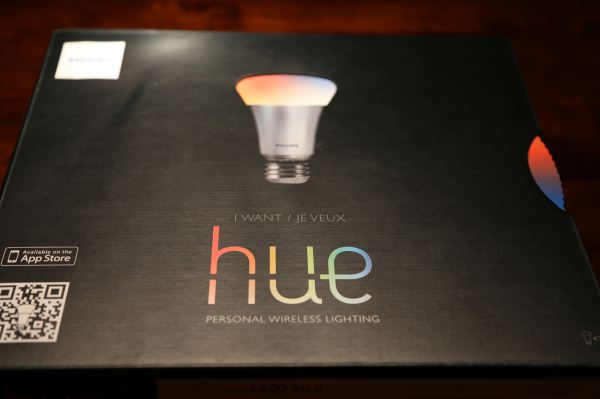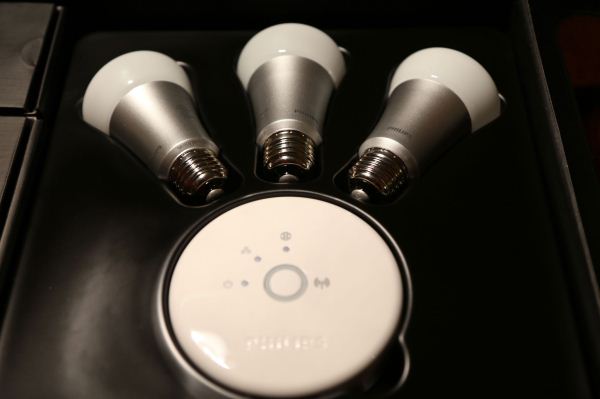Philips Hue: Automated Home Lighting Gets Colorful
by Ashu Joshi on March 1, 2013 12:50 AM EST- Posted in
- Gadgets
- Home Automation
- Philips
- Hue
- Lighting
Introducing the Philips Hue
Before we get started, we’d like to introduce Ashu Joshi to our readers. He has a background in networking and has used a variety of home automation devices over the years. As such, he brings a useful perspective to our staff and can help augment our review coverage. Note also that as with all of our articles, these pieces reflect the opinions of the writer(s) and are not in any way associated with or influenced by any other source (e.g. other employers).
Philips sent out a review sample of their new Hue lighting system, a set of three Hue lights with the Hue Bridge that allows you to remotely control the lights. Besides being able to turn the lights on or off, the big claim to fame of the Hue is that you can set the lights to a variety of colors, or you can even program them to cycle through colors. Home automation systems are often proprietary and can be quite expensive, so the entry of Philips into this market (albeit in a limited fashion) with their Hue lighting system has the potential to shake things up a bit.
The lights have colored LEDs, and while the initial pack only includes three Connected Bulbs (referred to informally as "bulb" or "light" throughout the remainder of this review), you can potentially add up to 50 lights throughout your house/property. One thing that hasn’t changed yet however is that pricing is quite high: the initial Starter Pack will set you back $200. But how does the Philips Hue work in practice, and could it be worth the cost of entry? Note that at present, the Philips Hue is only appears to be sold through the Apple Store as an “App-Enabled Accessory”, but Android is also supported. Long-term we will likely see support for other operating systems as well, but for now this is primarily an iOS/Android targeted device.
Packaging and Contents
One thing that immediately stands out with the Philips Hue is the packaging. It’s very well designed and eye-catching, and I love that you’re able to get a preview of the lighting options with the dial on the box. I set up my Philips Hue controller and bulbs recently, and my initial impressions have been very positive. It’s very easy to install and the experience of this lighting system is quite the change from your everyday lights. I uploaded a few videos of the package in action so you can see what it looks like.
Included in the package are three Connected Bulbs, and they’re quite a bit heavier than a typical light bulb. Most likely the added weight comes from the controller and antenna necessary to talk to the network, and possibly the addition of multi-colored LEDs adds a bit as well. Whatever the reason for the added weight, at least the heft makes you feel like you’re getting a bit extra for the $60 per light.
The other major item included with the Starter Pack is the Hue Bridge. This is a small, circular, lightweight controller with three LEDs on the top and a large circular button in the center used for the pairing function—Philips refers to it as the “link” button. On the side is an Ethernet port to connect to the home network and a power receptacle. The three LEDs show the status of Power, Ethernet, and Internet connections. There is no lettering to indicate what the LEDs are for but they use fairly common icons to indicate the function.
You also get a power adapter with a reasonably long cable for the Hue Bridge, though this is somewhat subjective. I have seen plenty of products where to save pennies they have short cables that ruin the setup experience and force the use of an extension cord, but for most users the Hue adapter should prove sufficiently long. An Ethernet cable is also provided to connect the Hue Bridge to your network, so plan ahead and realize that the Hue Bridge will need both power and network wires and place it accordingly.


















94 Comments
View All Comments
darkcrayon - Wednesday, March 6, 2013 - link
I think the main purpose for this product is the remote control and ability to dynamically adjust the color. "Fun" as it were. The energy savings over incandescent (if anyone still uses those) is more of a bonus. I have a couple of them in floor lamps (with the plastic "bowl" at the top) and they work fine in those, not ultra bright but bright enough for my needs. And again, a lot of fun to be able to bathe my room in blue light leaning back listening to music or what have you.Drizzt321 - Friday, March 1, 2013 - link
Given that I have a Pre3 with webOS, NOBODY has an App for my device. So can I set these up without the app? Is there a web interface that I can use? Or would I have to rely on the hacked HTTP control commands?JarredWalton - Friday, March 1, 2013 - link
If you don't have a smartphone, tablet, or iPod Touch, it appears you'd have to go the hacked support route. Ashu can correct me if I'm wrong. :-)darkcrayon - Wednesday, March 6, 2013 - link
Yeah, you'd have to get a hacked app running on a computer with which you could create a web interface... I did this with my set, there is a handy perl script out called Huepl that lets you control most aspects of the lights from command line commands, so I made a web interface "remote" so i could control the lights easily from any device (the phillips app lets you finely adjust colors and color sets but it isn't as handy and of course it doesn't run natively on a desktop computer).kmmatney - Friday, March 1, 2013 - link
wholly crap, that a lot of lumens...I'm not sure I have any place to put a 2800 Lumen bulb (and it doesn't look like you can dim it) except in my garage. I guess if you only have 1 or 2 light fixtures in a room it would work.Ninhalem - Friday, March 1, 2013 - link
http://arstechnica.com/gadgets/2012/11/in-living-c...Digital Deus - Friday, March 1, 2013 - link
There needs to be an easy way to locally control the light, either at the lamp or on the wall. Having to use an app all the time just to turn on the kitchen light is a non starter.degobah77 - Friday, March 1, 2013 - link
You can still turn on the lights by flipping the switch as you normally would. You just won't be able to dim it or change colors, it acts as a normal bulb at that point. Then as soon as you activate the app, you're in complete control again.Digital Deus - Friday, March 1, 2013 - link
The light always needs to have power. When you turn it off using the switch it's useless as a remote controlled light. The wall or lamp switch needs to be ZigBee.degobah77 - Friday, March 1, 2013 - link
That's what I just said. If you need the immediate gratification of lighting, then you can just flip the switch on and use it as a regular old bulb. If not, just take the 10 seconds to use the app and perform the same action, but with more options. Not sure what the issue is here.